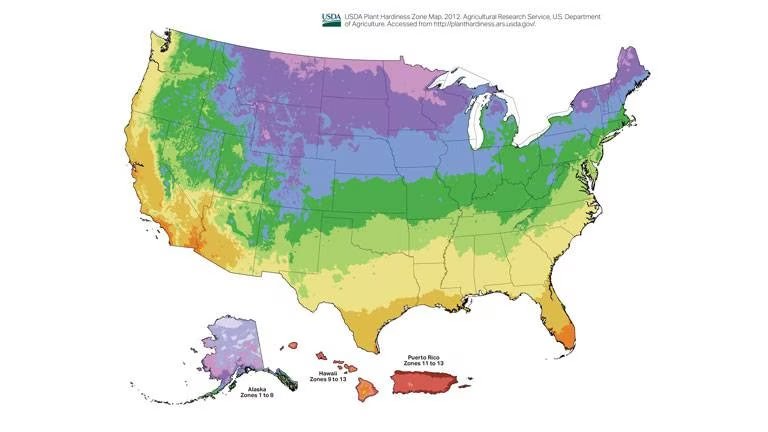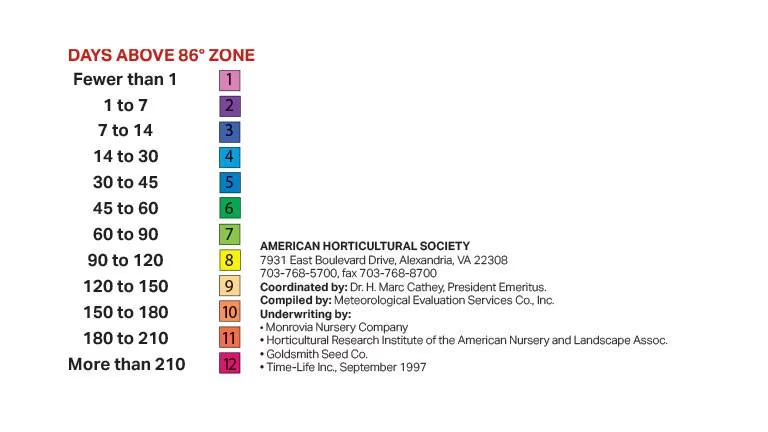By Sherri Ribbey | Photos by Jack Coyier (unless otherwise noted)
Cottage gardens have no firm “rules”—just the intention to get as much color, fragrance and flavor packed into the yard as possible.
Cottage
gardens are overflowing with life. As you wander one's paths, you’ll find a rich mixture of plants—flowers, herbs, fruits and vegetables. So it’s only natural that you’d also find an abundance of pollinators and other wildlife there. You can capitalize on the lush growth contained behind a picket or split-rail fence, too, by gathering bouquets of cut flowers to bring inside along with produce for the table.
Orderly is not a word that springs to mind when you think of a
cottage garden. On the other hand, this style isn’t completely arbitrary, either; there are some traits most cottage gardens share. Defining the space with a
fence like the one at right is one common characteristic. It also provides some stability and contrast to the exuberant plantings it surrounds. Love this casual, abundant look? Learn how to get it in your own garden here!
Follow Your Path
It just makes sense, you need a path of some kind to get to the flowers and vegetables you want to cut or harvest. Besides that, a path helps add structure and define the space. It doesn’t have to be fancy — gravel or concrete steppers will do the job just fine.
Don’t Worry About Floppy Foliage
There’s no need for staking in a cottage garden. Plants are often packed in tightly so they hold each other up, and any leaning stems just add to its casual feel. Low-growing overhanging foliage near the front of the border helps soften the edge of a path. But if a plant starts to become a tripping hazard, cut it back.
Shape Things Up
Cottage gardens have lots of different plants, but it’s amazing how many have similar flower shapes or habits. Keep an eye on the shape of your flowers and plants and put contrasting shapes next to each other to get the most impact. Plant daisy shapes with spikes and an upright habit next to one that’s mounding for a great-looking cottage garden every time!
Grow Your Own Food
Whether it’s tomatoes, squash, basil or edible flowers, cottage gardens often have a few
plants you can eat worked in among the blooms.
Roses, Re-Seeders and Old Favorites
There are some flowers that you’ll find again and again in cottage gardens.
Roses (Rosa spp. and hybrids) are always a favorite. And if they’re fragrant or reblooming, even better. Re-seeding annuals, such as this larkspur (Consolida ajacis), come back for years with just one sowing. You never know where they’re going to pop up next — those serendipitous combinations are the best! And if you’ve got bearded iris (Iris hybrid) from grandma or Oriental poppies (Papaver orientale) from the neighbor down the street, your cottage garden will be complete.
Cottage Color
Cottage gardens are primarily about flowers and lots of them—and with that comes loads of color. Whether you choose a limited palette or use all the hues in the rainbow, repetition will help keep the garden from looking too chaotic.
You can’t miss the sunny yellow flowers threaded throughout the casual foundation planting below. They give it a lively look that unifies this diverse group and adds warmth to the cool blue house trim. You could repeat the same plant, but why? This is a cottage garden after all!
Soft pastels provide a more relaxed effect. Surround a getaway or a patio with a color scheme like the cheerful one below and you’ll relish the time spent there after a long day at work.
 Pictured here: coneflower, perennial geranium, and lamb's ear
Pictured here: coneflower, perennial geranium, and lamb's ear
Keep it Colorful
Long-blooming or reblooming perennials, such as coneflowers (Echinacea spp. and hybrids) or perennial geranium (Geranium spp. and hybrids), extend the show and can bridge the gap between blooms from season to season.
Don’t Forget Foliage
Foliage can do a lot, even in flower-heavy cottage gardens. The broad silvery leaves of lamb’s ear (Stachys byzantina) provides contrast to the other leaves in the border. Plus it has the added benefit of being velvety soft to the touch.
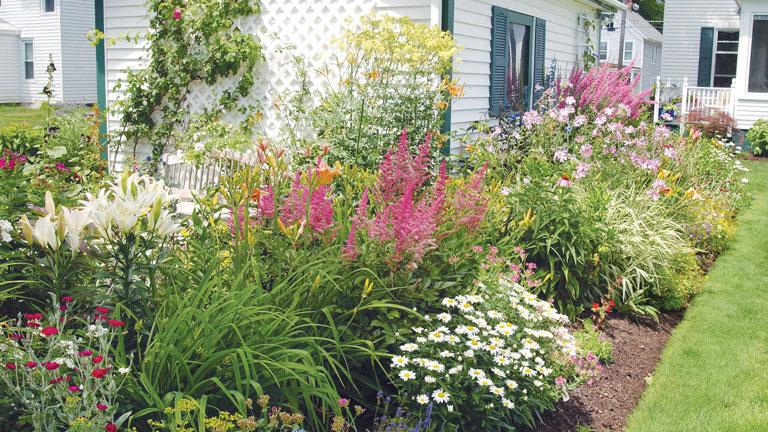 Pictured on the garden trellis: climbing rose
Pictured on the garden trellis: climbing roseFill any Empty Space
Traditional cottage gardens were often short on space, so enthusiastic gardeners made use of
every square inch. Whether your space is small or large, you can fill a bare wall with a trellis for supporting flowering vines. Be sure to match the trellis to the size of the vine. Lightweight annuals or small climbing roses (Rosa hybrids) work just fine on a section of lattice, like the one in the photo above.
Edge with Care
A crisp, tidy edge to your cottage garden defines the space and provides a bit of control to an enthusiastic group of plants. If you want to cut down on digging, add some whimsy by edging with found items. Wine bottles, old plates or whatever your imagination comes up with are all in keeping with casual cottage garden flair.
All types of plants are welcome in a cottage garden — bulbs, annuals, perennials, grasses — they all add their own charm.
Cottage Boundaries
Plants aren’t the only element of a great cottage garden. Fences and paths help define the space, enhance its style and provide much needed structure.
Traditional cottage
garden fences were wooden pickets along the property line. These days you have lots of choices in materials and the fence can be more ornamental than practical. Take a look at this wrought-iron one with a stone post below. It’s low and sits several feet inside the property line, providing an elegant backdrop for the eye-catching border. Be sure to choose a fence with open spaces between pickets. That allows air to circulate and discourages fungal diseases that often crop up in crowded plantings.
Cottage garden paths, such as the one at right, help tame plant-packed walkways by creating an edge to the borders. Most wind a little instead of heading straight to its destination—that would be too formal. Along the way don’t forget to pause and smell the flowers.
Make your fence easy to see over so you can chat with neighbors— a garden full of flowers will give you plenty to talk about.

Pictured here: mealycup sage; DESIGN: Detroit Garden Works
Easy-Care Fence
Wrought iron fencing looks a bit more formal than picket types and can be expensive to install, but it lasts for years with minimal care. Keep it in good shape with an annual inspection. If you find rust that won’t wipe away easily, use a wire brush to remove it, then sand the spot and apply rust-resistant paint.
Annuals Steal the Show
You can’t beat mealycup sage (Salvia farinacea) for its long season of bloom. Those spires of blue, purple or white, depending on the variety, attract attention wherever you grow them, last for weeks with little effort from you and butterflies love them.
Pictured here: pink sweet pea growing tall to the left of the building
Add Height
An obelisk or trellis gets vines, such as this sweet pea (Lathyrus odorata), up where it’s easier to appreciate its fragrance-filled blossoms.
Path Materials
You can use any material to create a path within this casual garden style. Simple concrete pavers you make yourself, turf and stone all work well but gravel is an age-old favorite. It’s economical, easy to maintain and makes a nice crunching sound as you walk on it.
Curve the Path
Install a path that curves to give your garden a casual look. Make it 2 feet wide or more so you can explore all the details without feeling like the crowded borders are pressing in on you.
Surround a Shed With Color
Illustrations by Carlie Hamilton
1. Accent the curve and entice visitors along the path with a container. This galvanized one is actually a 3-foot-diameter fire ring. It’s economical and easy to find at discount or home improvement stores.
2. Train rose canes up and around an obelisk to encourage more side branches to grow. That means more flowers for you to enjoy.
3. Stake hollyhocks if you want to keep them standing tall, but a little leaning is not an issue in the cottage garden.
Turn a shed into a hideaway and surround it with this beautiful cottage garden. Its soft color palette creates just the right mood for relaxing. You can sit back and enjoy the show as pollinators of all types visit this garden. Hummingbirds, bees and butterflies will entertain you as they flutter, dip and dart from one blossom to the next.
As you follow the gravel path to your private retreat, enjoy the fragrance of flowering tobacco or ‘John Davis’ climbing rose and cut a few flowers for a bouquet to enjoy when you get inside. On your way back to the house, snap off a zucchini or two. ‘Asti’, a bush variety, produces beautiful foliage as well as a bountiful harvest.
There’s plenty to enjoy in this summer-blooming bed. But you can extend the season by adding spring-blooming bulbs, such as tulips (Tulipa spp. and hybrids), hyacinths (Hyacinthus orientalis) or daffodils (Narcissus spp. and hybrids). Want to learn more about the plants growing here? Keep reading below the illustration!
Plant List (+ number to plant)
A Hollyhock Alcea rosea ‘Halo Candy’ and ‘Halo Cerise’ (7)
B Flowering tobacco Nicotiana alata (5)
C Delphinium Delphinium ‘Blue Donna’ (20)
D Geranium Geranium ‘Orion’ (3)
E Silver sage Salvia argentea ‘Artemis’ (8)
F Anise hyssop Agastache ‘Blue Fortune’ (4)
G Yarrow Achillea millefolium ‘Rosa Maria’ (5)
H Globe amaranth Gomphrena globosa ‘Fireworks’ (8)
I Pot marigold Calendula ‘Kablouna Lemon Yellow’ (19)
J Climbing rose Rosa ‘John Davis’ (1)
Cottage Garden Care
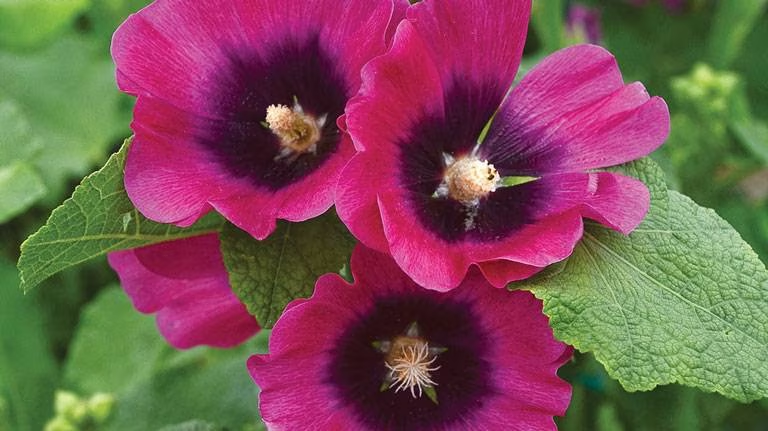
A. Hollyhock
Alcea rosea ‘Halo Cerise’
Biennial; gorgeous bicolor pale or dark pink flowers with a purple center rise above the rest of the garden in late spring to fall; full sun; 5 to 6 feet tall, 1 to 3 feet wide; cold zones 2 to 10, heat zones 12 to 1
Photo: Courtesy of www.PerennialResource.com
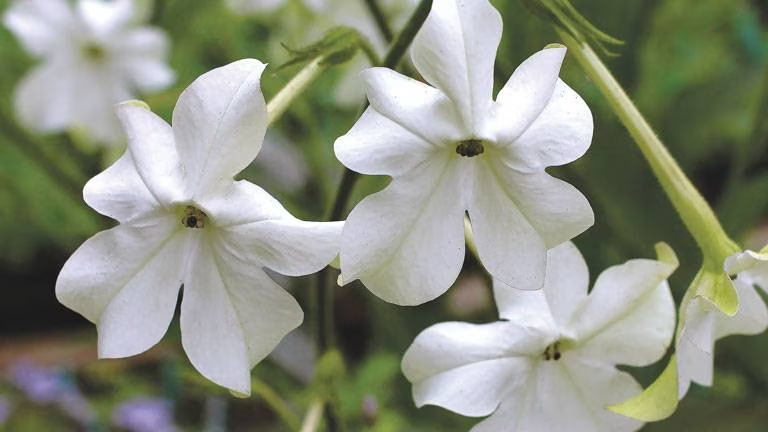
B. Flowering tobacco
Nicotiana alata
Tender perennial; fragrant white flowers release their sweet perfume in the evening from summer to fall; full sun to part shade; 3 to 5 feet tall, 1 to 2 feet. wide; cold zones 10 to 11, heat zones 12 to 1
Photo: courtesy of Annie’s Annuals & Perennials
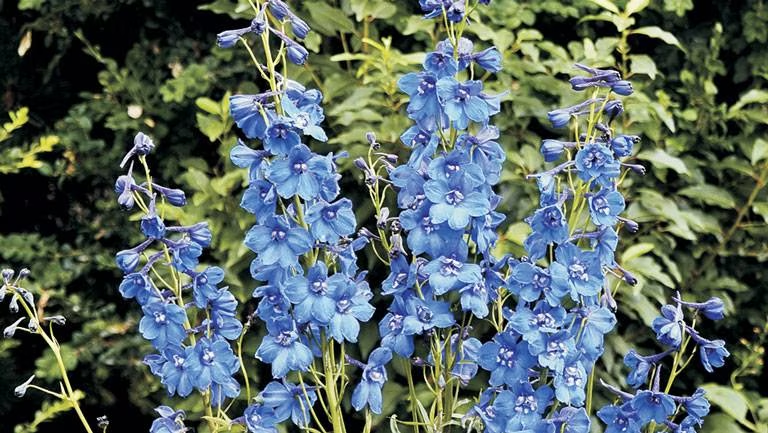
C. Delphinium
Delphinium ‘Blue Donna’
Perennial; blue flowers in late spring to late summer, easier to grow than other types with denser bloom spikes; full sun to part shade; up to 40 in. tall and10 in. wide; cold zones 5 to 9, heat zones 9 to 1
Photo: Courtesy of Ball Horticultural Company
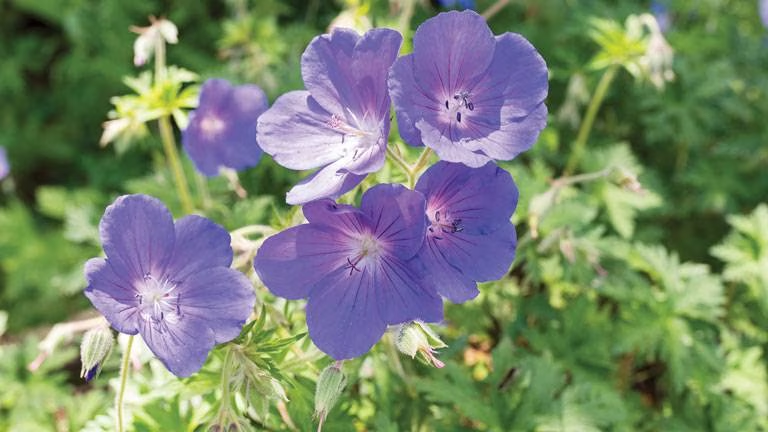
D. Geranium
Geranium ‘Orion’
Perennial; 1- to 2-inch purple-blue flowers last up to 2 months in summer and sometimes into fall; full sun to part shade; 18 to 24 in. tall, 24 to 36 in. wide; cold zones 5 to 8, heat zones 8 to 1
Photo: Courtesy of Select Seeds, Union, CT
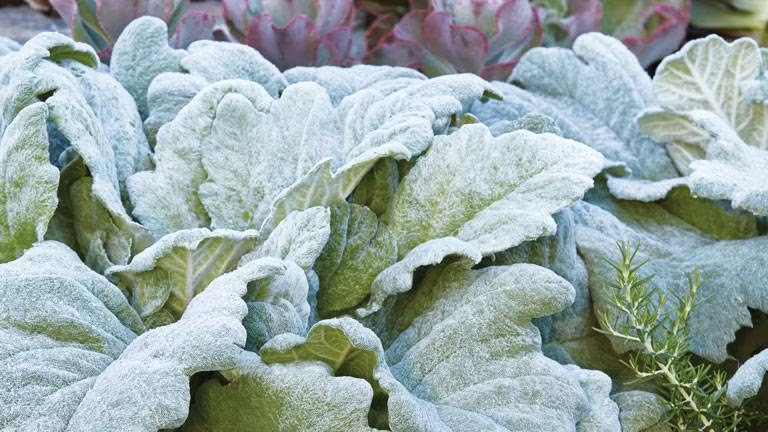
E. Silver sage
Salvia argentea ‘Artemis’
Perennial; white flowers in summer, self seeds, velvety soft silver-white leaves; full sun; 6 to 12 in. tall, 9 to 18 in. wide; cold zones 5 to 9, heat zones 9 to 1
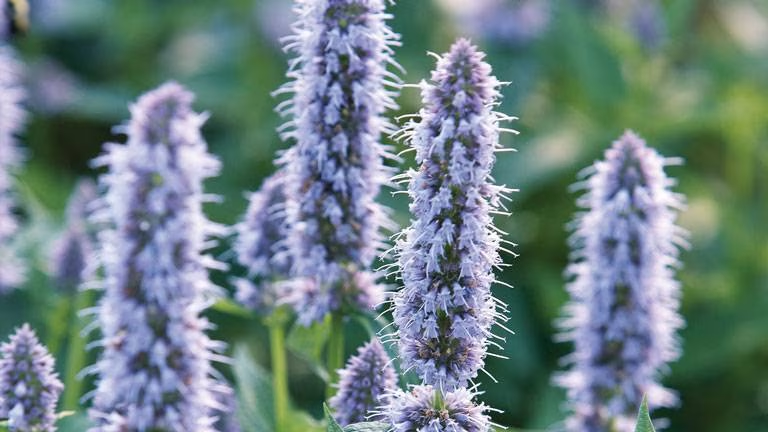
F. Anise hyssop
Agastache ‘Blue Fortune’
Perennial; blue-lavender flowers in summer, foliage has an anise scent and can be used to flavor drinks or in potpourri; full sun; 24 to 36 in. tall, 18 to 24 in. wide; cold zones 5 to 9, heat zones 9 to 1
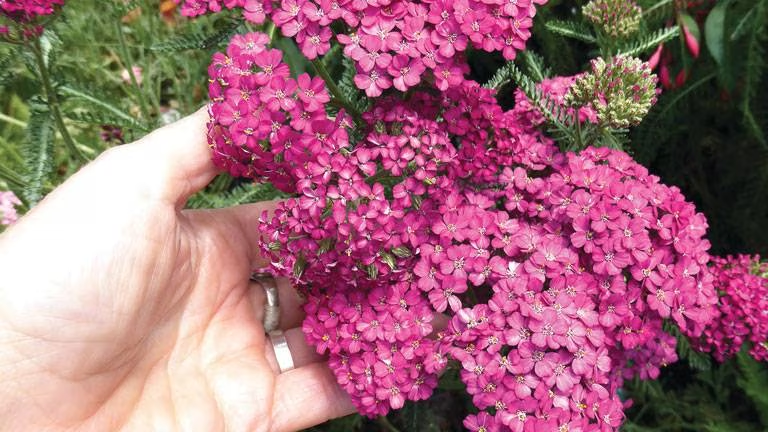
G. Anise hyssop
Agastache ‘Blue Fortune’
Perennial; blue-lavender flowers in summer, foliage has an anise scent and can be used to flavor drinks or in potpourri; full sun; 24 to 36 in. tall, 18 to 24 in. wide; cold zones 5 to 9, heat zones 9 to 1
Photo: courtesy of Annie’s Annuals & Perennials
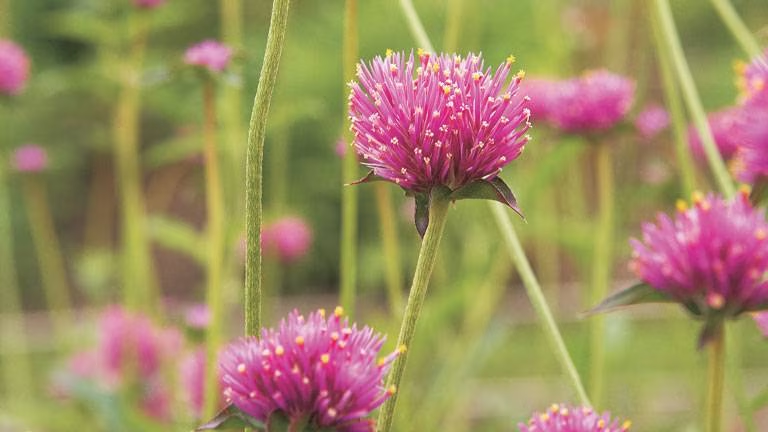
H. Globe amaranth
Gomphrena globosa ‘Fireworks’
Annual; a plethora of 1-inch purple-pink flowers tipped with yellow from summer to fall; full sun; 3 to 4 feet tall, 1 to 2 feet wide; heat zones 12 to 1
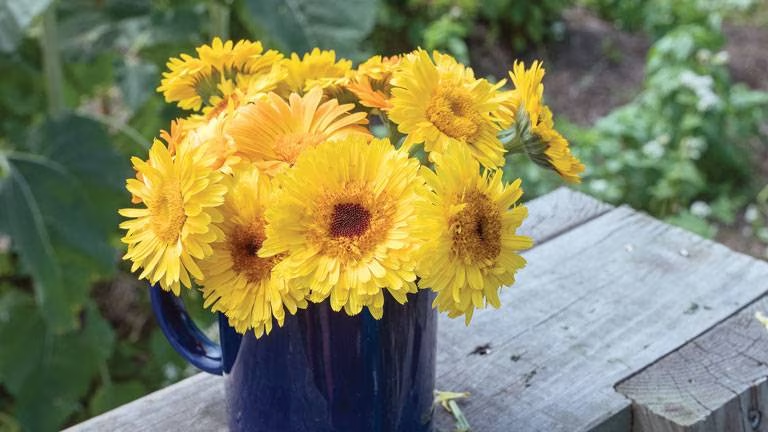
I. Pot marigold
Calendula ‘Kablouna Lemon Yellow’
Annual; lemon-yellow flowers in late spring to fall, add petals to your salad or soup; full sun to part shade; up to 24 in. tall and 12 in. wide; heat zones 12 to 1
Photo: Courtesy of Select Seeds, Union, CT
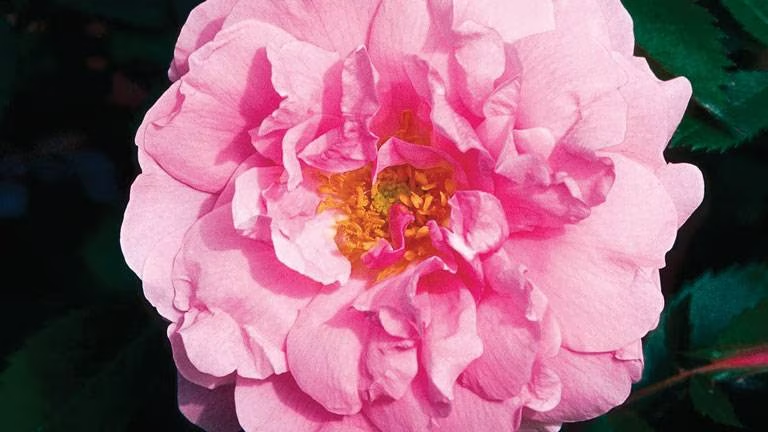
J. Climbing rose
Rosa ‘John Davis’
Shrub; fragrant double pink flowers in spring to fall, one of the best cold-hardy climbers; full sun; 6 to 8 feet tall, spreading; cold zones 3 to 7, heat zones 7 to 1
Photo:Courtesy of Bailey Nurseries, Inc. (J)
Previous
Next
A. Hollyhock
Alcea rosea ‘Halo Cerise’
Biennial; gorgeous bicolor pale or dark pink flowers with a purple center rise above the rest of the garden in late spring to fall; full sun; 5 to 6 feet tall, 1 to 3 feet wide; cold zones 2 to 10, heat zones 12 to 1
Photo: Courtesy of www.PerennialResource.com
Keep your cottage garden looking its best with regular watering, a slow-release fertilizer
in spring to keep plants flowering and a 2- to 3-inch layer of organic mulch to conserve water and keep weeds down.
Deadheading spent blooms is the biggest job, but be sure to leave some of the flowering tobacco late in the season if you want it to re-seed. You’ll find that pot marigold and hollyhock will re-seed, too, but their offspring won’t necessarily be the same color. The geranium may eventually get leggy—if that happens, cut the stems to within a few inches of the ground. New growth will take off and you’ll soon have a second flush of blooms. Silver sage sends up a tall bloom spike in summer that you can remove if you want to keep a tidy edge or leave it for pollinators to enjoy. Prune the climbing rose in early spring by removing any dead stems and as it ages cut large woody ones back to the base of the plant. This will encourage new green stems that flower more.
Know Your Zone
What’s a zone, and why does it matter?
Cold-Hardiness Zones
The
USDA cold-hardiness map has long been the authority to help gardeners pick plants that will survive through the winter. It designates zones based on average annual minimum temperatures throughout the United States. A plant’s cold-hardiness zone rating indicates where it’s likely to survive the winter.
Heat-Tolerance Zones
This map of the country is divided into 12 zones to indicate the average number of days in a year when the temperature goes above 86 degrees F. This is the temperature at which plants begin suffering and are unable to process water fast enough to maintain normal functions. Zone 1, the coldest zone, has fewer than one day. Zone 12, the hottest zone, has more than 210 days above 86 degrees per year.




















